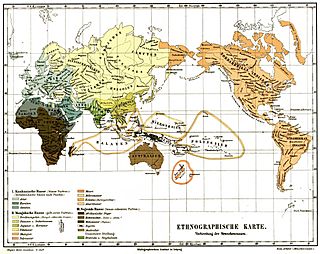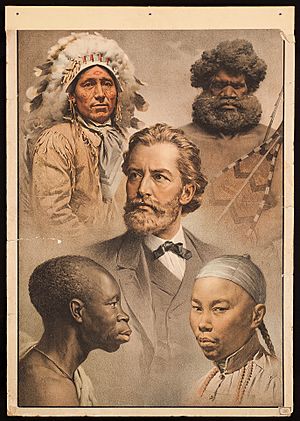Historical definitions of race facts for kids

| Caucasoid: Aryans Semitic Hamitic Negroid: African Negro Khoikhoi Melanesian Negrito Australoid Uncertain: Dravida & Sinhalese |
Mongoloid: North Mongol Chinese & Indochinese Korean & Japanese Tibetan & Burmese Malay Polynesian Maori Micronesian Eskimo & Inuit American |
Some scientists spoke of three races of mankind: The Caucasian race living in Europe, North Africa and West Asia, the Mongoloid race living in East Asia, Australia, and the Americas, and the Negroid race living in Africa south of the Sahara. Other scientists had different ideas and spoke of four or five races. These ideas were popular from the late 18th century to the middle of the 20th century. Because these ideas belong to former times, they are called historical definitions of race or historical race concepts.
Today, scientists agree that there is only one human race. Modern genetic research has shown that the idea of three (or four, or five) races was wrong.
19th century
Johann Friedrich Blumenbach's classification, first proposed in 1779, was widely used in the 19th century, with many variations.
- the Ethiopian/black race.
- the Caucasian race/white race
- the Mongolian/yellow race
- the American/red race
- the Malayan/brown race
Middle of the 20th century
The mid-twentieth century racial classification by American anthropologist Carleton S. Coon, divided humanity into five races:
- Negroid (Black) race
- Australoid (Australian Aboriginal and Papuan) race
- Capoid (Bushmen/Hottentots) race
- Mongoloid (Oriental/Amerindian) race
- Caucasoid (White) race
Racism
There was much prejudice based upon this way of looking at the world. The Europeans and Asians both regarded themselves as superior to the other skin colors. Racism, a non-scientific theory or ideology, was that a particular race was superior or inferior. It argued that in the races that make up the human race, there are deep, biologically determined differences. It also states races should live separately and not intermarry. A supporter of racism is called a racist. These attitudes in turn supported the horrors of African slavery, Apartheid, the Jim Crow laws, Nazism and Japanese imperialism.
Images for kids
-
Blumenbach's five races
See also
 In Spanish: Historia del concepto de raza para niños
In Spanish: Historia del concepto de raza para niños






